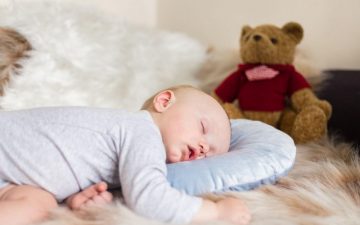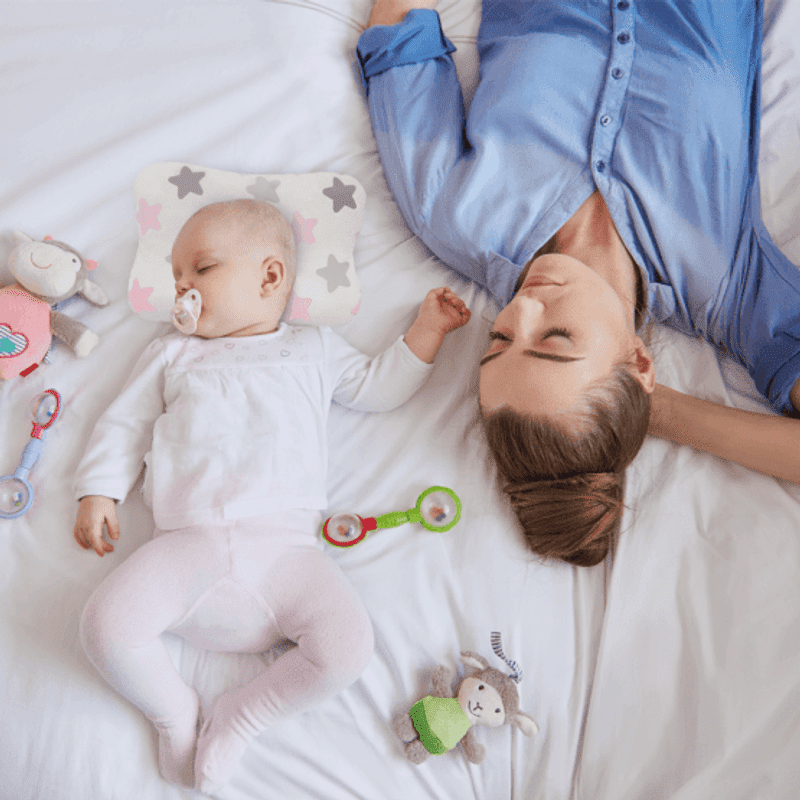
As parents, we all know that our babies need restful sleep to grow and develop. Not only will it be beneficial for their development, but while they’re sleeping you will also get that well-deserved downtime before the next rounds of never-ending child-rearing tasks.
Many first-time parents will find putting their child to sleep difficult. Sometimes they wake up after a few hours of nap and will have a hard time falling back asleep. This may be due to unwanted noise, the room temperature, or an uncomfortable bed. If you relate to the struggle or simply are looking for sleeping tips, this article will serve as a guide to restful sleep for your baby, notes on which baby head support pillow to pick, and naptime tricks for your newborn.
How Long Should the Baby Sleep?
Babies need to follow their own schedule of sleeping. For example, infants need to wake up every 2–3 hours to feed or 3–4 hours for bottle-fed babies. However, their overall hours spent sleeping depend on how many months they are.
According to the Sleep Foundation, newborns (0–3 months) need 14–17 hours of sleep per day, infants (4–11 months) need 12–15 hours of sleep per day, and toddlers (1–2 years) need 11–14 hours of sleep per day.
Babies need enough sleep so their brains and bodies can develop. However, at least 25% of babies and children under the age of five have difficulty sleeping. To prevent your child from having sleeping problems, you can adjust the environment to be ideal for your little one’s sleep.
The Ideal Sleeping Environment for Babies
Babies are fragile beings, so they should always have a safe place to sleep. The best sleeping environment for babies is in their parents’ room because you will be able to monitor them at night and prevent any accidents from occurring. However, if your baby can’t stay in the same room with you, then it’s ideal to have a cradle inside a different room with a baby monitor so you will be able to reach them in case of an emergency.
The ideal temperature for the room they sleep in is between 68–72 degrees Fahrenheit or 20–23.3 degrees Celsius. If you don’t have a temperature checking device, you can base the room temperature on your own comfort. The room must be at least cool enough for you to want to sleep in.
Babies should also be sleeping on something that can keep their heads aligned with the rest of their bodies. The recommended position for babies to sleep in is lying on their backs, so their heads and body need to be supported by something soft. The Ashtonbee’s baby head support pillows are made with 100% organic cotton that can help maintain your child’s spine alignment while they sleep, keeping them comfy for the entire night. It can also be used as inserts for bassinets, cradles, and your car seat.
Do Babies Need Pillows?
Infants may need pillows to prevent the flat head syndrome, but it’s best to consult your paediatrician first. For an infant, it’s best to use soft and breathable head support pillows for a baby. It is important to note that you should not use large pillows for your baby. This will only make them uncomfortable because their necks are still very weak and small compared to the size of these pillows.
A newborn baby pillow needs to be soft, hypoallergenic, and anti-bacterial for your infant’s health. As your baby grows in the following months, you can use baby pillows that are slightly bigger and wider.
What Makes a Baby Pillow So Different From Regular Pillows?
Regular pillows are not suitable for infants because they contain chemicals that can be hazardous. You will know if your pillow contains these harmful substances if it smells bad or has a chemical smell caused by the foam and latex used in making regular pillows. For babies, especially those with sensitive skin, getting an irritating rash from using regular pillows isn’t impossible.
They may also be made too high for your child’s neck and head. As a result, they won’t properly support the proper body alignment your little one needs. This is why an item like a head support pillow for a baby is made specifically for your growing infant.

Naptime Tricks
For newborn babies, it is recommended to swaddle them- before putting them down for a nap. This can help encourage deep sleep during the first three months of life because they are sensitive beings who will wake up if something doesn’t feel right. Swaddling also helps prevent babies from scratching themselves or even hurting other people or objects.
For Newborns
The best way to get babies used to falling asleep is through swaddling, white noise, and dark surroundings. Babies are sensitive beings who depend on environmental factors for sleep to stay healthy and grow up well. This means that it would be ideal if the room was dark and there were no distractions around. It’s also a good idea to use white noise, which can be anything from the sound of the fan or rainfall outside.
For Babies Who Can Roll Over by Themselves
Swaddling may not be the best idea for babies who have reached three months. Instead, it is recommended to use a white noise machine and keep your baby in an environment that promotes sleepiness, like dim lighting or using night lights.
For Toddlers Who Can Walk Around by Themselves
For children aged between a year old up until three years, you can keep them in their crib with the door closed and a nightlight on. You can decrease the temperature a little to encourage them to relax and not think about playtime.
Once you see that they are ready to sleep, be sure to put the best baby head support pillow in their crib so they can have quality sleep all night long.

Access the Secret to Baby’s Restful Sleep With Ashtonbee Pillows
With the right environment, simple tricks to help them sleep, and a comfortable sleeping area, your child will get the sleep that their body needs. Let your child achieve a restful sleep in their crib, or even when traveling, with baby head pillows specially made for them.
Aside from getting cute and comfy pillows, you can also decorate your baby’s room to make it aesthetic and zen. You can read our blog about crib bedding design ideas among other articles about your baby’s sleep and health.



